We’ve made it to the part you’re probably most excited about – the Micro Sales Funnels!
(If you haven't already, please read WTF #1 & WTF #2 before getting into this article!)
These are the “typical” sales funnels you probably envision when you think of and read about sales funnels.
They’re the up-sell funnels, webinar funnels, product launch funnels, book funnels, call back funnels, and any other type of funnel you can think of.
Of course, every “guru” has their own take and twist on how these things can, and should, function; however, their goal remains the same – to sell something.
Now, let’s talk about these awesome funnels and how to use them!
Quick Overview
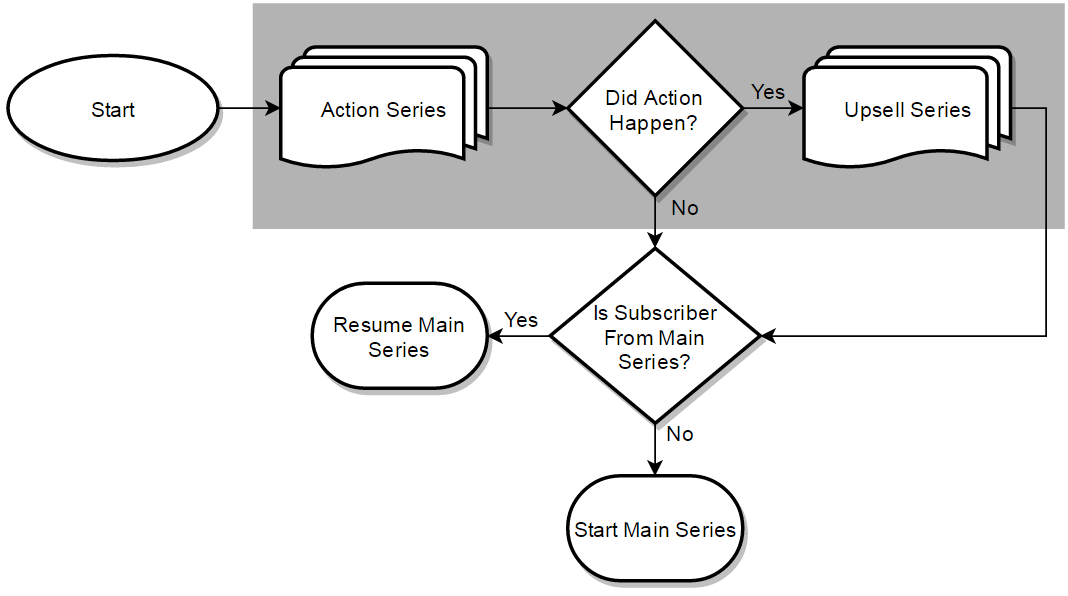
Above is an example of what a Micro Sales Funnel can look like.
No matter what the middle section contains, the Start and End will look the same.
The Start
The Start occurs when an individual shows interest.
But, what exactly does that mean?
Interest can be shown in a variety of ways:
- Click – Someone clicks a link in one of your emails or on one of your ads, showing they’re interested in a certain topic, product, service, etc.
- Pageview – When someone looks at a specific page on your website, it shows they’re interested in a certain topic, product, service, etc.
- Purchase – When an individual purchases a product or service from you, it’s a dead giveaway they’re interested in a certain topic, product, service, etc.
- Specific Lead Magnet – When someone opts-in to receive a Lead magnet for something related to what you want to sell. For example, a mini-guide called “5 ways we decreased Facebook Ad spending by 89%” – we know they’re interested in Facebook Ads.
- Note: In WTF #5 you will find a Specific Lead Magnet plan that will blow your mind!
- Phone Call / Reply – If someone calls or replies to one of your emails, depending on the reasoning behind it, it could certainly show interest in a particular product, service, topic, etc.
- Survey – Similar to a phone call or reply in that someone is explicitly telling you what they’re interested in.
- Points (CRM) – More “advanced”; however, if you’re using a CRM tool you can use points to gauge interest and trigger Micro Sales Funnels based on points. For example, if someone looks at your sales page 5 times, you know they’re highly interested and may just need a tad more persuasion – exactly what a Micro Sales Funnel will provide.
As you can see, there are many ways an individual can enter one of your Micro Sales Funnels.
After The Start (The Funnel Part)
After the Start, you have the “funnel part.” Again, this can look like pretty much anything; however, in the example above we use an Action Series and an Upsell Series.
- Action Series – An email series that addresses the subscriber from different angles in order to try to “connect” with them and drive them to take action (make a purchase). For example, one email could be very logical and explain, by-the-numbers, why your deal is great. The next email could be a story about someone who found success with your product. Another email could be benefits driven and explain the results one can expect.
- Upsell Series – A series of emails triggered by an action (purchase) and attempts to move them to the next logical step. For example, they purchase a $7 guide to solve a problem and the upsell is a step-by-step video course for $97.
NOTICE! WARING! READ ME!
As I've stated in the previous WTF articles, email doesn't necessarily mean “email” – it means engagement – ie. email, retargeting ads, phone calls, Facebook messages, direct mail, etc. And, you can do more than one at a time!!!
- Send an email, use retargeting ads, send Facebook messages, and hell… if it's important enough… call them and/or send them direct mail! Got it?!
- I say “email” because it's easy to understand; however, there are many, many ways to interact with your audience so, please keep that in mind!
- Recommended Read: Email Marketing Is Dead! … and it's going to be ok
The End
Just like the Start, the End will be the same no matter what the “funnel part” looks like.
If the individual entered into your Micro Sales Funnel from your Main Series – they will re-enter the Main Series and pick up right where they left.
If the individual entered into your Micro Sales Funnel via another source, ie. Facebook Ad to a Specific Lead Magnet or they made a direct purchase, they’ll start the Main Series from the top.
The “Simplest” Sales Funnel

This first Micro Sales Funnel model is even more basic than the example I outlined above; however, don’t let its simplicity fool you – there’s beauty in simplicity.
As with all Micro Sales Funnels, the Start is when interest is shown.
After an interest is shown, an Action Series is triggered. While I’ll go into greater detail on Action Series later in this article series, for the time being – an Action Series is a series of emails (engagements) that try and motivate the audience member to take action (ie. buy something).
Whether the individual performs the action we want them to or not, the funnel will end just like any other Micro Sales Funnel. The individual will either be returned to their previous location within the Main Series or, in the instance of a new subscriber, they will start at the beginning of the Main Series.
If the idea of adding any of the next few Micro Sales Funnel models sounds too daunting, try adding a few of the “Simplest” Sales Funnels and you’ll start to see some amazing things happen!
For example, one of my students added seven of these funnels to his pre-established Main Series and here are his results:
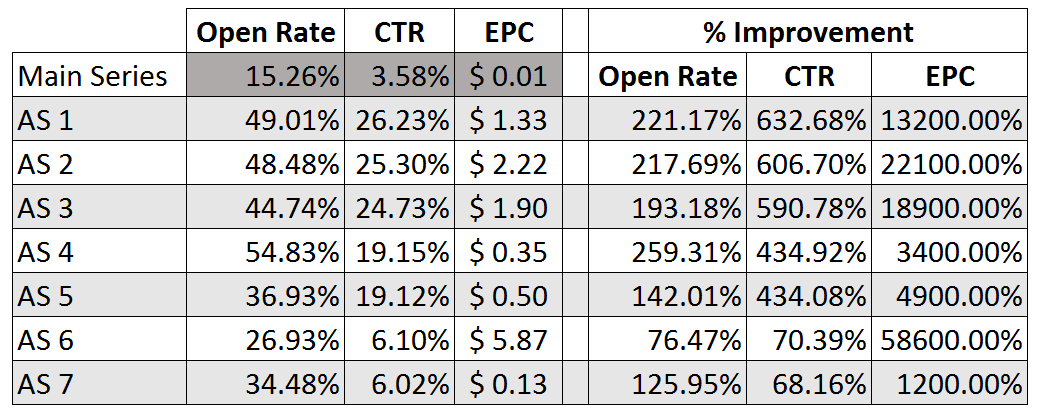
The average open rate for his Main Series was 15.26%, Click-Through-Rate (CTR) was 3.58%, and Earnings-Per-Click (EPC) was $0.01.
While the open rate is a little low and he probably needs to address his subject lines, his emails have an above average CTR. This shows he’s able to gauge interest based on what links people are clicking.
Also, the EPC for his Main Series was only $0.01, which is perfectly fine. Remember, the intent of the Main Series is to gauge interest while continuing to build and maintain relationships.
The AS # represents the individual Action Series. In this case, each Action Series was triggered after an individual looked at one of his products’ sales pages. Each Action Series contained only three emails and most of the content was third party product reviews with a call-to-action (CTA) to visit the sales page and buy the product now!
Very simple.
However, as you can see, every Action Series outperformed the Main Series in open rate, CTR, and EPC by a landslide!
Again, all he did was add the “Simplest” Sales Funnels (Action Series).
He didn’t incorporate any up-sells or cross-sales. He kept everything really simple; however, his results have been tremendous!
Conclusion
The “Simplest” Sales Funnel is the starting point. This should be your first journey into the wild and crazy world of Micro Sales Funnels.
The good news is while they’re really easy to setup, they can make a massive impact to your bottom line!
The “Classic” Sales Funnel
The next Micro Sales Funnel is certainly the most popular and infamous; McDonalds built their empire based on it.
“Would you like fries with that?”
Yes, I’m talking about the “Classic” up-sell funnel.
This type of funnel is the true money maker because it directly increases customer order size, and thus, lifetime value.
Understand This…
I’m about to throw several different diagrams at you all named “Classic” Sales Funnels.
It may be overwhelming, especially if you’ve not seen something like this before.
Ultimately, I want you to understand the premise of the “Classic” Sales Funnel. If someone buys something, you try to sell them more. If they don’t buy it, you offer a down-sell or follow up and attempt to make the sale later.
No matter which of the fancy “Classic” Sales Funnel diagrams you’re looking at, remember – if your customer purchases something, sell more. If not, down-sell or follow up to sell later.
How To View This Type Of Funnel
Before getting into the fancy diagrams, I need to clarify how to view these “Classic” Sales Funnels as they can quickly become complex.
There are two perspectives to take into consideration when designing your “Classic” Sales Funnels:
- Long-term: Emails or engagements between offers
- Instant: Order flow (at checkout)
Due to these two different perspectives, these funnels can look very different depending on your business model, what you’re trying to accomplish, and your platform.
It doesn’t always make sense to include emails or other engagements between offers.
Maybe what you really want to sell is after the individual goes through this funnel.
For example, coaches will frequently use a “Classic” Sales Funnel to sell digital courses and training, in order to get people in the door. But, what they really want to sell is private coaching. Instead of really focusing on getting people through the “Classic” Sales Funnel, they just keep it really simple and place all their focus on a Product Launch Funnel, Webinar Funnel, or Call / Application Funnel.
Finally, in other instances, you may be limited by your particular platform and want to consider adding a 3rd party tool like ClickFunnels.
The “Classic” Sales Funnel Models
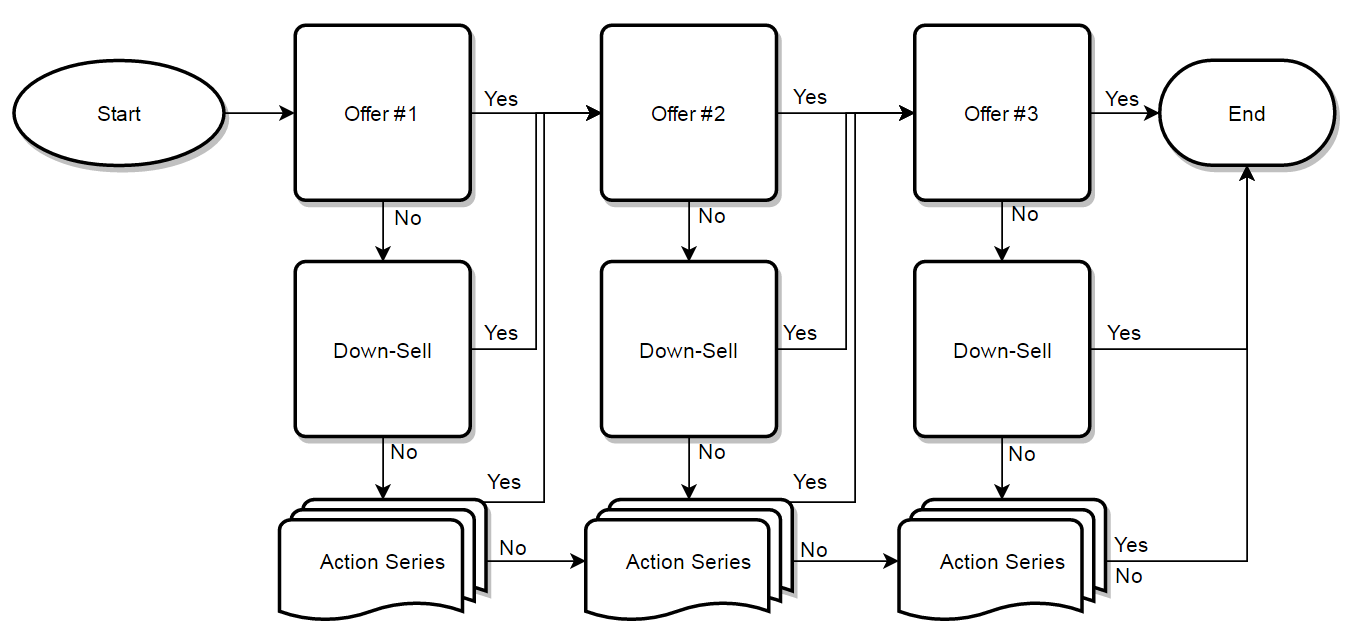
I call this first one the “Mega Classic” Sales Funnel because it’s about as complex as “Classic” Sales Funnels can get.
Basically, the big idea is this:
If someone buys something, you make another offer right away (at checkout). If they buy it, you make another offer; however, if they don’t buy it, you either down-sell or send emails (engagements).
9 times out of 10, your funnels will not be this complex. There are a lot of moving parts, which means it can break easily. A broken funnel isn’t going to do you any good.
However, I wanted to open your eyes to what is possible.
Conversely, this is also a “Classic” Sales Funnel:

Very simple.
This version would likely occur at checkout and can be considered an “order flow”.
Basically, the big idea is this:
Regardless of whether someone buys the previous product, you’re going to make more offers. There won’t be any down-sells or follow up on previous offers – it’s either a yes or no on the spot, and that’s it.
This is essentially the McDonald’s funnel – the funnel starts when you purchase a burger, then they offer fries, then a drink, then to supersize it, then a sundae, and finally to opportunity to donate to a charity. Before you know it, you’ve spent $20 on a $1 burger!
More often than not, you’ll use a version between the “Mega Classic” and the simple funnel above.
One version that’s really popular in the Internet marketing world is the “Trip Wire Funnel”.
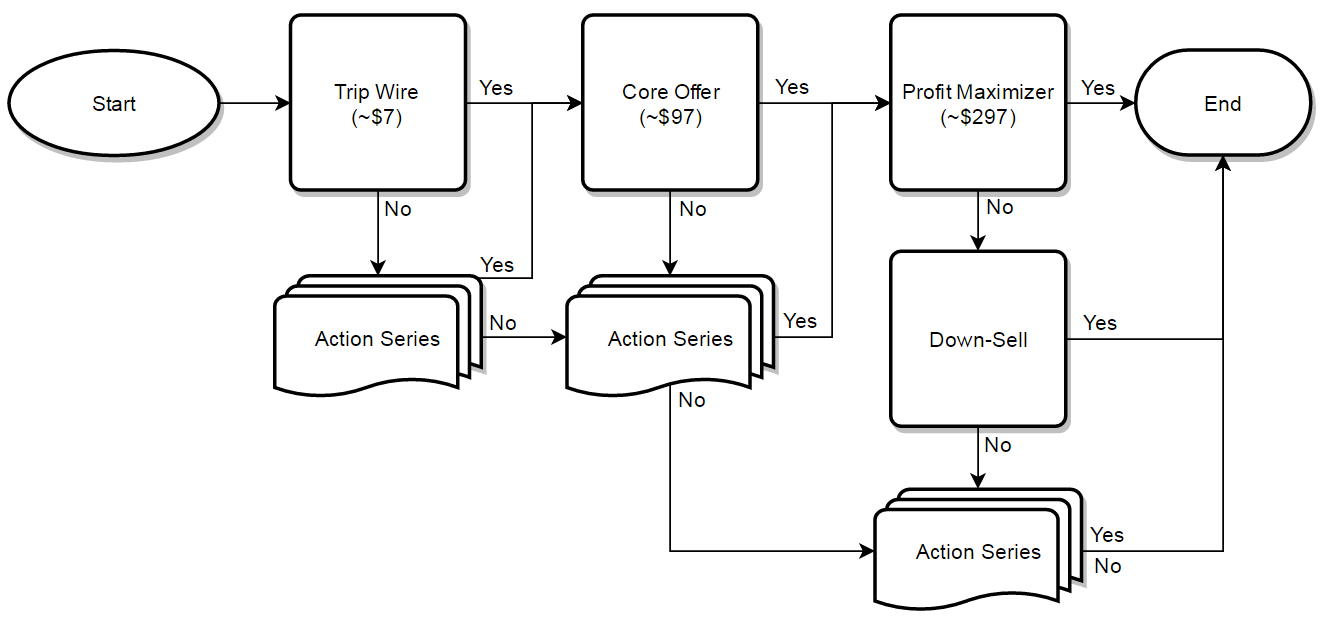
The theory behind this funnel is that as soon as you get someone to open their wallet and spend some money with you, they’re much more likely to continue spending.
It starts with offering a low priced product that’s too good to pass up called a “trip wire”. People buy this product like it’s going out of style and “trip” into your funnel where you sell your “Core Product” (what you really want to sell) and your “Profit Maximizer” (a high-end product or service that really rings the cash register).
A frequently seen trip wire is a free + shipping offer for a book. This works incredibly well because a physical book has a relatively high perceived value and opens the door to sell courses and coaching.
If you have a great complementary offer for the front-end, the “Classic” Sales Funnel model below may work well for you:
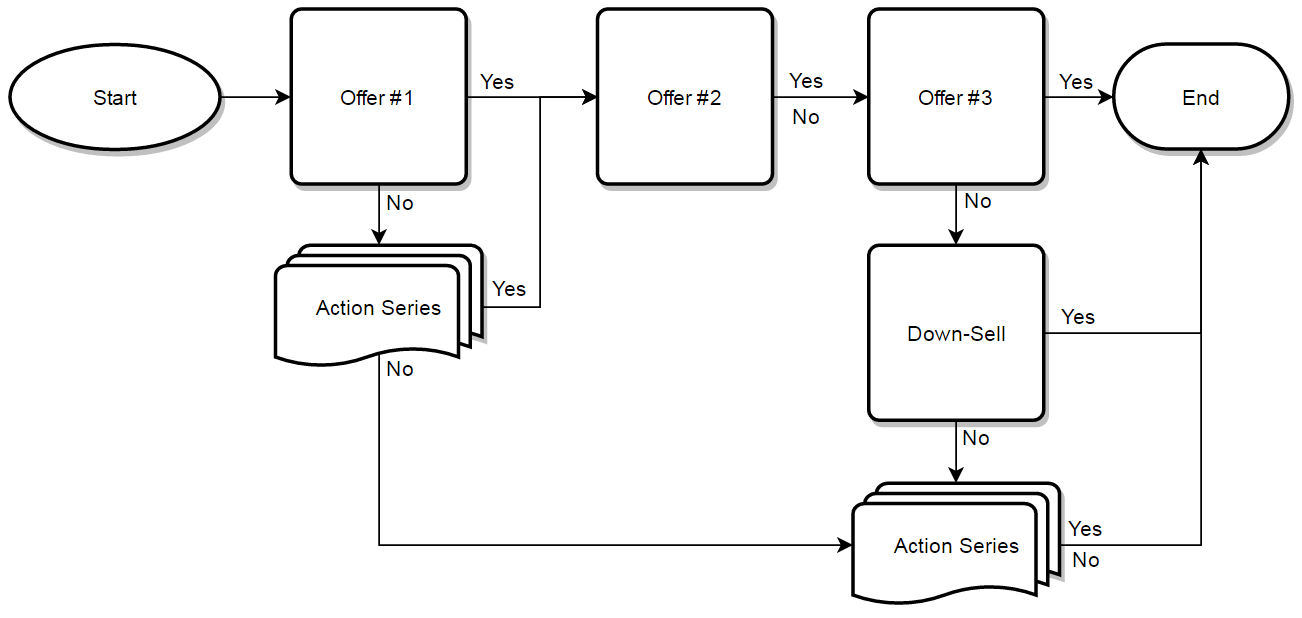
Basically, you work hard to sell your front-end offer (Offer #1) so they see Offer #2. Offer #2 is a complementary product to Offer #1, meaning it’s only really helpful if they’ve purchased Offer #1. Offer #3 is generally a stand-alone offer, meaning you don’t need Offer #1 or Offer #2 for it to be great, and it’s usually higher priced.
If they don’t purchase Offer #3 right away, they’ll be offered a down-sell and finally an Action Series in a last-ditch effort to make the sale.
Conclusion
The “Classic” Sales Funnel is the most popular Micro Sales Funnel because it works very well and can make a dramatic impact on the bottom line.
While the “Classic” Sales Funnel can look very different depending upon your unique setup, its purpose remains the same – to sell more. This, of course, can be accomplished across a wide timeframe through emails and other engagements and/or instantaneously at checkout.
The Product Launch Funnel
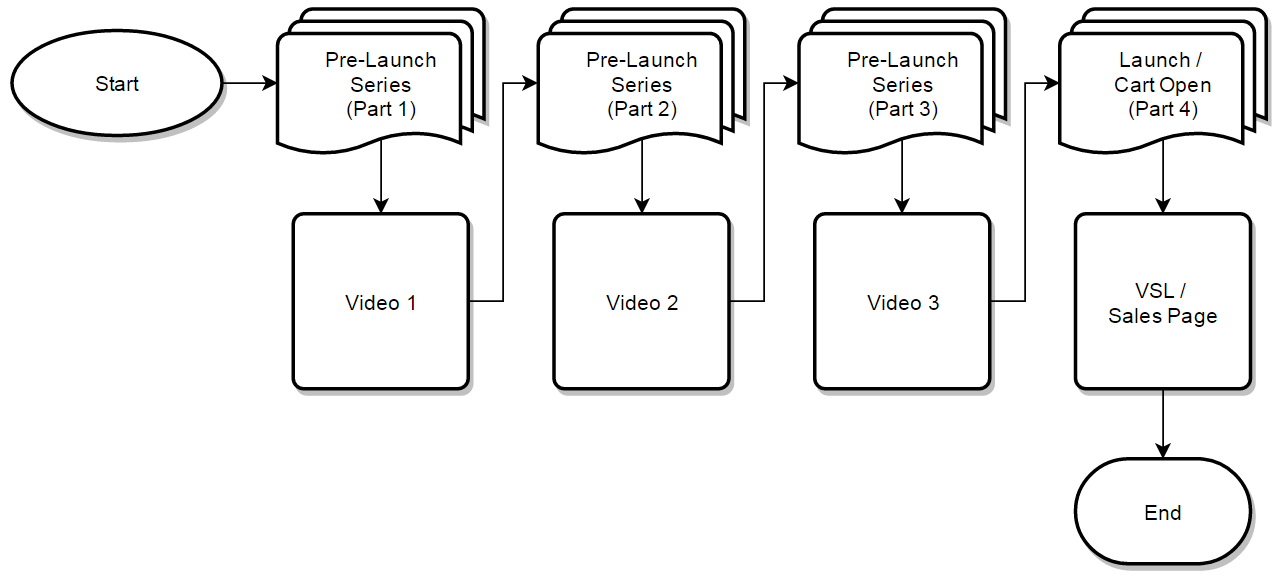
The Product Launch Funnel is wildly popular for more expensive products, like digital courses.
It’s typically three content based videos, that entertain and educate, and concludes with a fourth video that makes the offer.
The general flow is this:
Someone shows interest in your upcoming product launch by opting-in, clicking a link, viewing a page, etc. – all the normal “interest gauging” triggers.
From there, they receive a few emails (engagements, ie. retargeting ads, text messages, Facebook messages, etc.) directing them to video 1. After they watch the first video, they receive emails about video 2. They watch it, and then receive emails about video 3. They watch it and then receive emails to video 4, which is typically a Video Sales Letter (VSL).
The power behind this funnel comes from two key aspects:
First, this funnel provides insane value in videos 1-3 by giving away your “best stuff”. If you do these videos right, it will make your offer a no-brainer. People will think, “If his free stuff is this amazing … I can’t imagine how absolutely incredible his paid stuff is!”
The second source of this funnel’s power comes from the Launch / Cart Open phase.
During this phase scarcity is introduced because the cart will close.
There are a few ways to close the cart. The way you do it depends on whether your Product Launch Funnel is a true, one-time event or if it’s evergreen (always available).
If it’s a true, one-time event, then it’s easy to introduce scarcity because you’re going to take the offer off the table at a certain date and time. If the individual misses it, too bad.
If it’s an evergreen launch, you need to introduce scarcity in another manner because you won’t be removing the offer. You can do this by removing bonuses or by increasing the price, if they don’t purchase by a certain date.
The Video Pattern
Before I go any further, I want to address something – I keep saying “video”; however, you don’t necessarily need videos. You could use other resources like blog posts or PDFs to develop a product launch series.
Videos are often used because digital video courses are typically sold during a product launch funnel. It makes sense to keep everything in the same medium.
With that being said, you should follow a pattern or strategy for delivering the first three videos. There’s some psychology and positioning at play.
There’s a proven science behind this content and there are folks that make millions regularly from these product launch funnels.
While I’ll give you my particular formula in a moment, I want to share two other guys’ formulas … or at least where to get them. (It wouldn’t be ethical, and it’s probably illegal, to just paste their formulas here; however, you can get them straight from the books I’m about to recommend. Each book is less than $10, but contains invaluable information.)
- Jeff Walker’s “Launch”: http://www.thelaunchbook.com/
- Pages 89-97
- Russel Brunson’s “DotCom Secrets”: https://dotcomsecretsbook.com/
- Pages 222-227
My Formula: Teach, To-Do, & Tease
While I typically follow the aforementioned formulas because they know what they’re doing, I sometimes find them hard to follow. They require certain information to be presented, like success stories.
Success stories are important, and you need to have people find success with your product; however, there’s a chicken and egg situation here. You can’t really have success stories (besides your own) before your product exists, right?
While you can do a limited pre-launch to get feedback and success stories, doing so takes time and requires an audience.
If you’re short on time and/or lack an audience, what I’m about to explain may work very well for you!
I call it the “Teach, To-Do, & Tease” formula. In each video, you teach something, give the individual a simple task, and tease what’s to come.
I’ll explain this formula through an example.
Let’s pretend I’m selling an expensive course titled, “How to Become a World-Class Facebook Ads Guru”.
Across the Product Launch Funnel, I would teach a segment of the course.
Which segment? Either the “coolest” part or the beginning. Sometimes you can’t teach the “coolest” part because your course is progressive and you can’t do the “cool” stuff without having completed steps 1-5 first.
You also want to ensure the segment you teach provides a clear deliverable.
Think of it like a mini-course with a beginning, middle, and end.
Basically, whether or not they purchase the full course, I want them to receive at least one clear result from my training.
You never want to leave anyone feeling like they’ve been duped … like you’ve just dragged them along so you could sell them your product.
You want them to accomplish something, and if they want more – there’s a full course on the topic.
Back to the example, regarding Facebook Ads, I can’t start with the “cool” stuff because without having the proper groundwork in place, the “cool” stuff can’t happen.
The segment taught is the beginning and it’s titled, “How to build custom audiences that know, like, and trust you with Facebook’s advertising platform.”
In video 1, I’ll teach people how to install the Facebook tracking pixel on their website, tell them to go do it, and tease the conversion tracking training coming in video 2.
In video 2, I’ll teach them how to track conversions and create custom conversions which will help them create specific audiences … which is what is covered in video 3.
In video 3, I’ll teach them how to create custom audiences based on pages viewed, conversions made, and how to use this to create lookalike audiences of similar people that will know, like, and trust you!
Finally, in video 4, I’ll pitch the full course by explaining how what they just learned will help them tremendously moving forward; however, it’s only a small segment of becoming a World-Class Facebook Ads Guru!
See how it’s all a natural flow into selling the full product? It doesn’t require having testimonials and success stories because you’re helping them find success!
If you help someone solve a problem for free, they’re more likely to reciprocate when you’re trying to solve a bigger problem for money.
Conclusion
The Product Launch Funnel works great when selling high priced products, like digital courses, because it gives you the opportunity to “prove” yourself before asking for the sale.
You also want to follow a proven pattern for your videos because there is psychology and reasoning behind the content of each one.
Finally, you need to open and close the cart and make it a big deal by introducing some form of scarcity.
The Webinar Funnel
In the good ol’ days, people and businesses used to host seminars, but now they can get in front of more people faster and more easily via webinars.
These types of sales funnels have become wildly popular recently due to the fact they convert like gangbusters!
Here’s a common Webinar Sales Funnel:

Similar to the Product Launch Funnel, the Webinar Funnel is typically used for higher-priced products and services because you have people with you for 60+ minutes. This gives you enough time to convey your message fully, give the pitch, and answer questions.
While you can automate your webinar to make it evergreen, the live aspect gives these presentations their power.
When it’s live, everything comes across as fresh, new, and when you give your call-to-action, there’s an inherent sense of urgency. You’re ending the presentation at X time, and once it’s over, the deal is gone.
The general flow is this:
Someone shows interest in your webinar by opting-in via a webinar registration page. They’re then enrolled in your pre-webinar autoresponder series where you send a few videos and resources to prime and excite the individual for the upcoming webinar. Then, you host your webinar.
Ideally, the individual attends your webinar, sees your offer, purchases it, and ends the Micro Sales Funnel.
But, if they don’t attend your webinar, you can send a “replay autoresponder series” which consists of a few emails that present the individual the opportunity to watch a replay of the webinar.
Hopefully they watch the replay, see your offer, purchase it, and end the Micro Sales Funnel.
If they don’t watch the webinar or the replay, they won’t see the offer, so this particular Micro Sales Funnel is ended.
If the individual sees the offer, either during the live webinar or the replay, but doesn’t purchase it, you can follow up with an Action Series. The Action Series tries to sell them on it by answering more questions, handling objections, sharing more success stories, or even offering a discount in a last-ditch effort to make the sale.
Turning It Evergreen
While the great power of webinars comes from being live, you can still create the same live feel and automate the entire process.
By turning your webinar into an evergreen presentation, you’re able to give presentations 24/7/365!
There are a million different tools to help you do this; however, there are two elements a tool can’t provide that you must take into account before going the evergreen route.
First, the webinar you turn evergreen needs to be a recorded live webinar.
This means you can’t sit in your office, record yourself talking about some slides, editing the clip to cut out the “uhs”, and then launch your evergreen webinar.
Remember, the power of webinars comes from being live. People can tell in a heartbeat if something was scripted and performed alone or held live.
If someone attends your webinar and they’re presented with a scripted presentation, it will come across as unauthentic.
Don’t get me wrong, scripted, pre-recorded, and edited presentations are fine; however, call it a presentation or training – don’t call it a webinar.
A webinar has the connotation of being live and if you don’t fulfil that, people aren’t going to be as happy and excited.
Plus, there are benefits of performing live. You see what does and doesn’t work, what questions people have, etc. – it really helps to refine your presentation.
The strategy, then, is to hold a handful of live webinars, get some real time feedback, adjust your presentation, then record one and use it as your evergreen webinar.
The second element you need to provide is a way to contact you, the presenter. This can be something as simple as a chat box below the webinar.
As much as humanly possible, no matter if the webinar itself is pre-recorded, you want to be live in the chat room to field any questions.
Some people are ready to buy; however, they will have the simplest question stopping them from whipping out their credit card. If you’re able to answer their question immediately – you’ll get yourself a new customer!
Live chat may not always be possible, especially if you’re running webinars 24/7/365, so the second best option is to follow up via email; however, you lose the “in the moment” momentum, which may result in lost sales.
Either way, you need to make yourself present as much as possible, even if the webinar itself is recorded.
Other Webinar Blueprints
Just like with the “Classic” Sales Funnel, there are a bunch of ways to layout a Webinar Sales Funnel depending on your needs.
There are arguments for and against offering replays and follow up emails that pitch the offer.
Some webinars are live, four hour long events and only during those four hours can you purchase the offer.
While others are heavy on getting individuals to watch the replay and follow up intensely on the offer.
No one way works better than the other all the time, just figure out what works best for you!
Self-Liquidating Offer

This blueprint looks similar to the original with one exception, immediately after registering for the webinar, the individual is met with a Self-Liquidating Offer or SLO.
A SLO is similar to a Trip Wire, in fact, their names are often used interchangeably. It’s typically priced under $10 and is too good to refuse; however, a SLO doesn’t necessarily “trip” someone into the other offers.
Instead, its sole purpose is to recoup ad spend to acquire leads.
Offer Up!
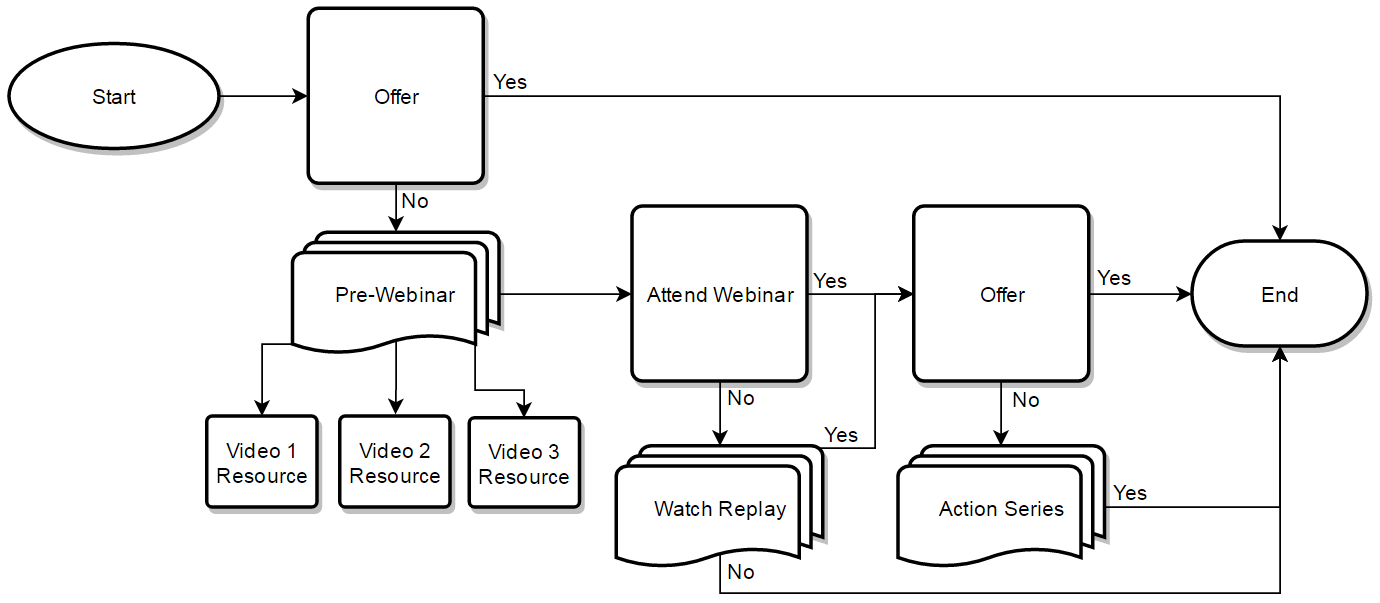
This blueprint is similar to the SLO example above in that the subscriber is immediately greeted with an offer upon registering for the webinar; however, in this instance they’re met with the main offer.
There are a couple reasons you may want to try this:
In some instances, people will buy your offer right away without going through the entire webinar process. They get what they want faster and you don’t have to work as hard!
Another theory is that by seeing the offer first, they’re primed for when you make your official pitch. They say it takes 6-8 touches before you’ll make the sale, this is a simple way to add another touch.
No Pre-Webinar
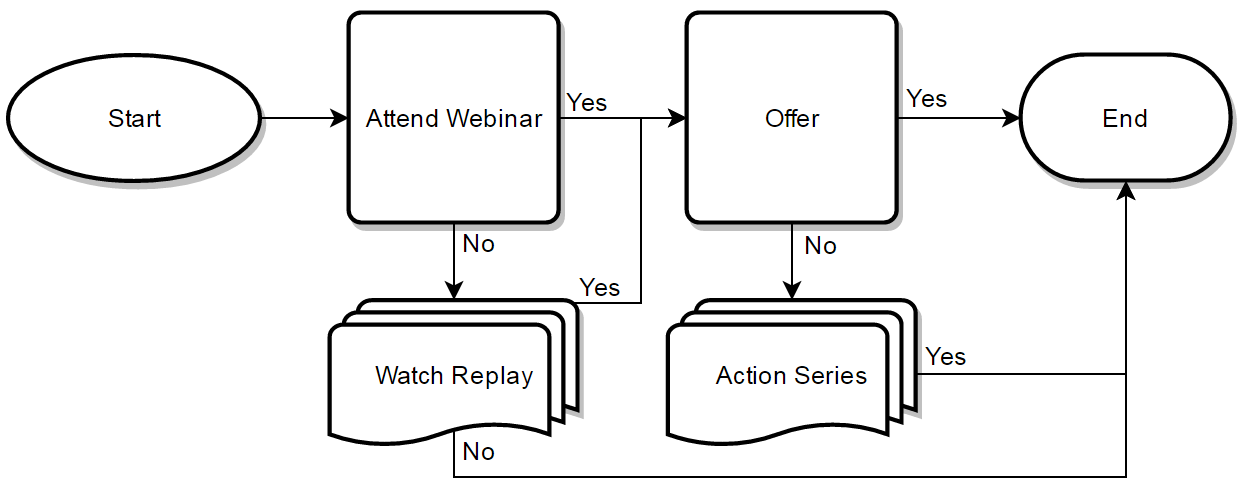
In many instances, especially if your webinar is evergreen, you won’t have enough time to go through an entire pre-webinar series … and you don’t have to!
No Pre-Webinar, No Replay
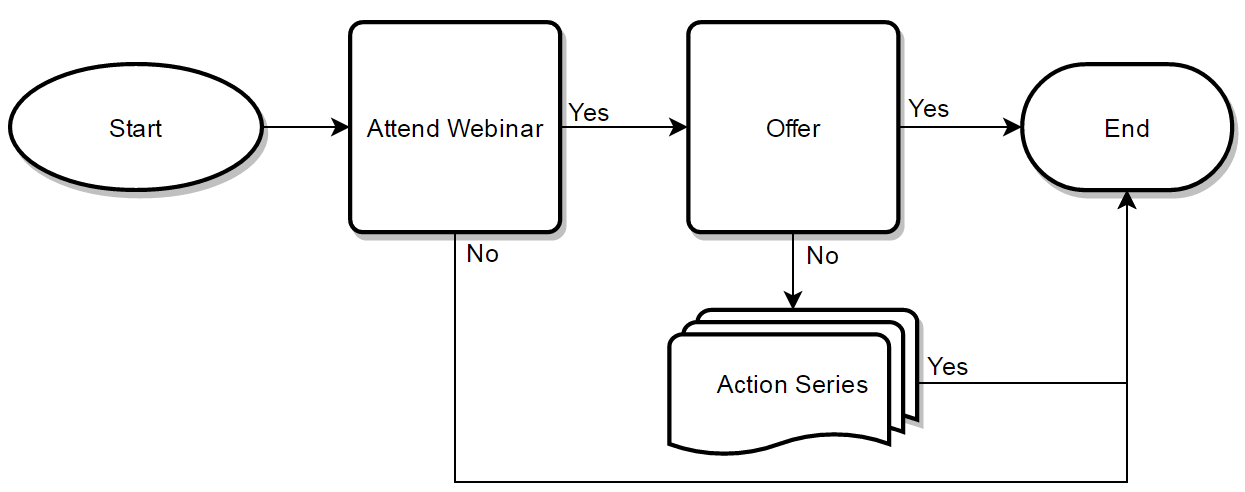
If you don’t want to offer a replay, don’t!
The Webinar Presentation
Just like with the Product Launch Funnel, there’s an art and science behind the content you present in your webinar.
Before you launch your own webinar, make sure you attend a bunch of webinars – especially those in the same niche as you that you know are successful.
Since launching a webinar is a piece of cake, every small business on the planet has one. Unfortunately, not all are successful and you don’t want to emulate those.
Attend the successful ones. Take notes on how they open, present their content, and pitch their offer.
Understand how they engage with their audience and handle objections.
Pay attention and really study what they do. It’s going to help you tremendously.
Finally, I recommend grabbing Russel Brunson’s Perfect Webinar training from https://perfectwebinarsecrets.com/.
It costs less than $5 and contains about three hours of training. He outlines, step-by-step, how to structure your webinar presentation for maximum effectiveness.
Conclusion
The Webinar Sales Funnel is an effective way to sell higher end products and services. They give you enough time to go into detail on your offer plus the live aspect makes them really engaging.
Having the ability to answer questions and squash objections on the spot makes them incredibly powerful.
There’s also the opportunity to make them evergreen so they’re working for your 24/7/365. But, when you turn a webinar evergreen, make sure it’s a recorded live version and you make yourself available to answer questions.
Finally, before launching your own webinar, make sure you study other successful webinars to really get a good grasp on how to present yours.
The Call / Application Sales Funnel
While Product Launch and Webinar Funnels are great for selling many types of high-ticket products and services, sometimes you really need to talk to the individual before they feel comfortable making the purchase.
Other times, you need to feel comfortable selling them the product or service. You may want to qualify them before moving forward on a deal.
Naturally, these situations typically entail talking to the potential customer/client, which is why we have the Call / Application Sales Funnel:

The general flow is this:
An individual starts the funnel by clicking a “contact” or “application” link in an email or on your site. Or, they may opt-in to contact you (2-step, more on it later).
From there, the individual either schedules a call with you or fills out your application. Or they don’t.
Assuming they do, they receive the “Homework Or Pre-call Follow-up” autoresponder series.
- Homework: Works as both a qualifier and as a chance to sell yourself more. The homework is typically something simple, like watching a few videos so they are prepared for the upcoming call.
If they do the homework, great! You know they’re highly interested. If not, then maybe they’re not the right customer for you.
- Pre-call Follow-up: This follow-up series can be used similarly to the “Homework” setup outlined above in that you give some material to consume. It also serves to remind the individual they have an upcoming call with you.
People will forget they’ve scheduled a call with you. Fortunately, most scheduling tools have built-in functionality for sending reminder emails. You can set it up to send a call reminder 24 hours, 4 hours, and 20 minutes out.
Hopefully, the individual does the homework and/or you speak to them and they become a customer of yours. Now all you have to do is serve them!
If they don’t become a customer, they end this Micro Sales Funnel and either enter or resume the Main Series so you can begin gauging more interests.
Let’s go back to the beginning of this Micro Sales Funnel – “Did Individual Schedule Call Or Fill Out Application?”
A lot of people will land on your call scheduling and/or application forms without actually filling them out.
You don’t want to ignore these people because they’ve shown interest in your offer.
In this case, follow up via an Action Series with the CTA being to schedule the call or fill out the application.
Hopefully, they do what you want and will flow through the rest of the Micro Sales Funnel; however, if they don’t, they either enter or resume the Main Series.
The 2-Step Approach
While you’re able to easily track people’s actions and gauge their interests when they’re already on your list – you don’t want to miss out on people that aren’t on your list.
To capture these new people, I recommend the 2-Step Approach.
It works like this – before an individual even lands on your call scheduling or application form, they enter their email address.
For example:
An individual clicks on the “Schedule A Call” button in the top navigation menu:

Clicking that button pops up a lightbox opt-in form that requests their email address:
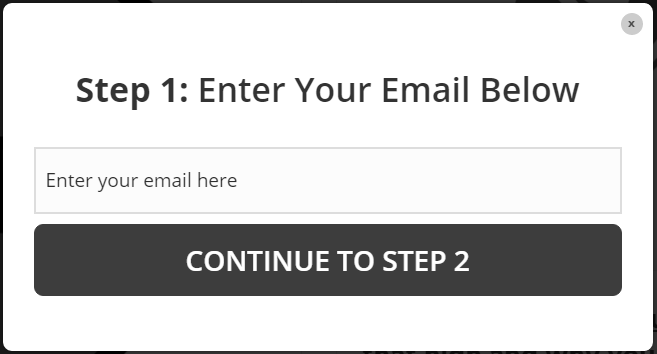
It makes perfect sense these steps would be required to schedule a call – ie. “Step 1: Enter Your Email Below” and “Continue To Step 2”.
Step 2 is simply the scheduling or application form:
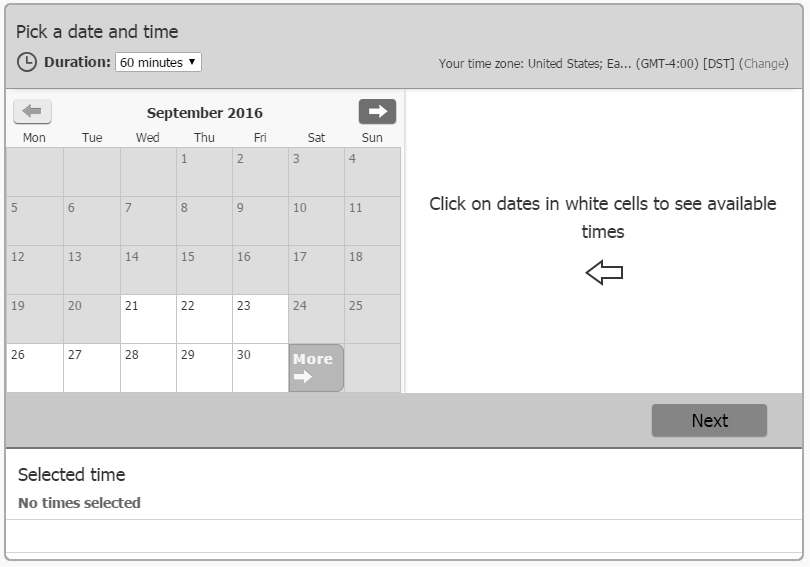
Again, hopefully they go straight through the process; however, if they don’t – you collected their email address in “Step 1”, and are able to follow up with an Action Series that motivates them to finish the process.
Conclusion
The Call / Application Funnel is perfect for when you need to talk to someone or need them to fill out an application to prove they are a good fit.
If you offer personalized services, this funnel might be one to check out and implement!
Other Funnels
As I stated at the beginning of this section, every sales funnel “guru” has their own sales funnel model(s) they teach.
This is great! More people to learn from and more models to follow and implement.
Even greater, they all work with the Interest Driven Sales Funnel concept – they’re all [typically] Micro Sales Funnels.
You still incorporate your interest gauging Main Series and when an interest in a product or service is shown, instead of launching one of the Micro Sales Funnels outlined above, you simply launch that particular “guru’s” funnel.
After the individual has gone through that funnel, they hop back into the Main Series and continue their journey until they show interest in something else.
The Interest Driven Sales Funnel concept is very plug & play friendly. I want you to try other Micro Sales Funnels. If you come across one that sounds interesting, try it. If it doesn’t work, you can always cut that Micro Sales Funnel off and add in a new one for the same product or service.
Here are a few funnel “gurus” that you may find insightful:
- Russell Brunson – Founder of ClickFunnels. Has written several books on sales funnels. Has dozens of Micro Sales Funnel models, plus talks about stacking (combining) them for maximum effectiveness. He has too many products and resources to list and all of them are great, just Google him.
- Aaron Fletcher – Has the “Fletcher Method” and the “One Page Marketing Funnel”. The Fletcher Method is an ideology behind structuring your business and creating great offers. If you’re struggling with figuring out what to offer, I recommend checking out his method. His One Page Marketing Funnel is essentially a Product Launch Funnel; however, he incorporates retargeting, phone calls, and even snail mail which make it more effective. Learn more at http://fletchermethod.com/
- Ryan Deiss – Owns more companies than I can count and all are powered by very solid sales funnels. Like Russell Brunson, he has a lot of stuff to offer and is worth a Google search; however, what’s likely most interesting to you is his Follow Up Machine. It’s a similar concept to the Interest Driven Sales Funnel I teach in that it incorporates your entire business, gauges interest, etc., but he, of course, has his own spin on it. Learn more at http://followupmachine.com/backdoor
- Todd Brown – Another sales funnel “guru” worth checking out. He has a bunch of different Micro Sales Funnel models that he teaches, all with his unique spin. Learn more about Todd and his funnels at http://marketingfunnelautomation.com/
- Traffic and Funnels – A heavy focus on developing client acquisition systems, similar to the “Call / Application Funnel” I outlined above. If you offer higher end products or services that require conversation, you may find their training to be incredibly helpful. Learn more at http://trafficandfunnels.com/
Those are just some of the people I follow with regard to sales funnels. Of course, there are many others out there and if you find someone that really resonates with you, follow them!
Combining Funnels
As if the possibilities for Micro Sales Funnels weren’t already endless, in this final section, we’ll briefly discuss combining them to make them even more effective!
In general, the “Classic” Sales Funnel is the perfect addition to most Product Launch and Webinar Funnels because it makes perfect sense to combine the two:
Product Launch => The “Classic”
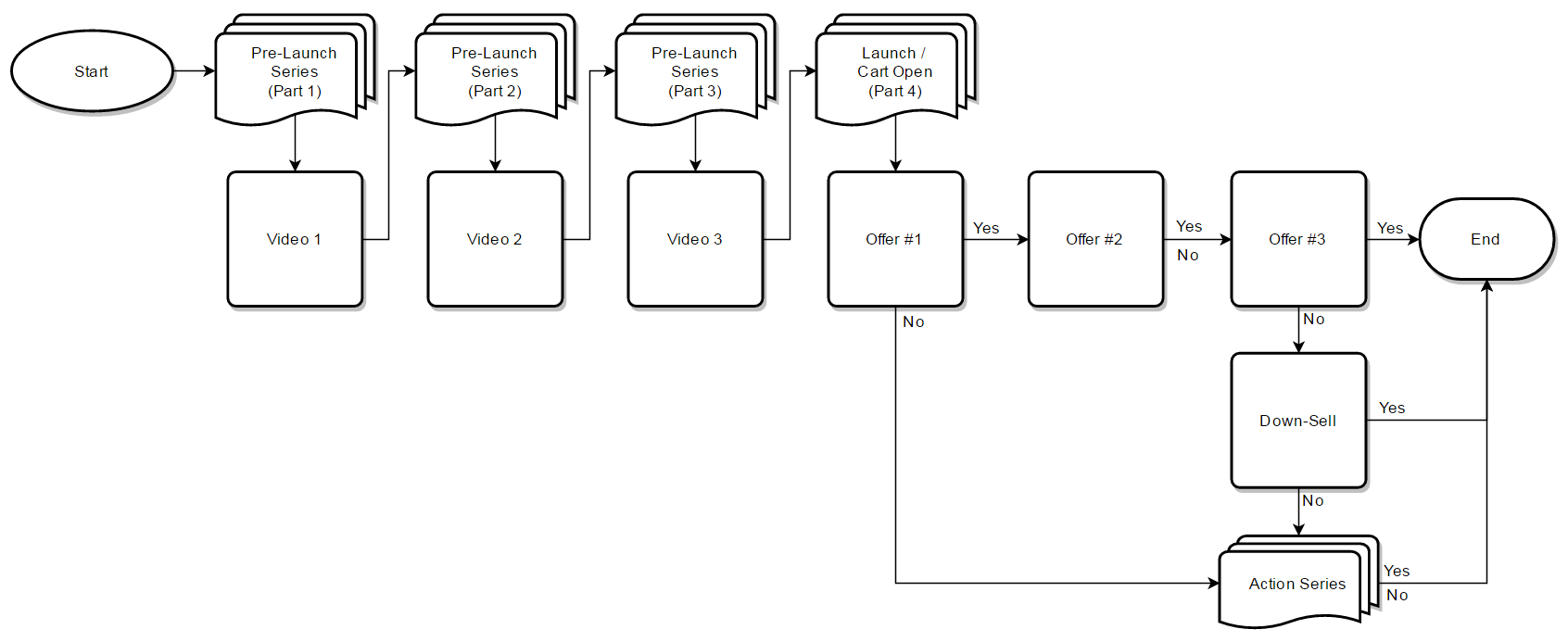
Webinar => The “Classic”
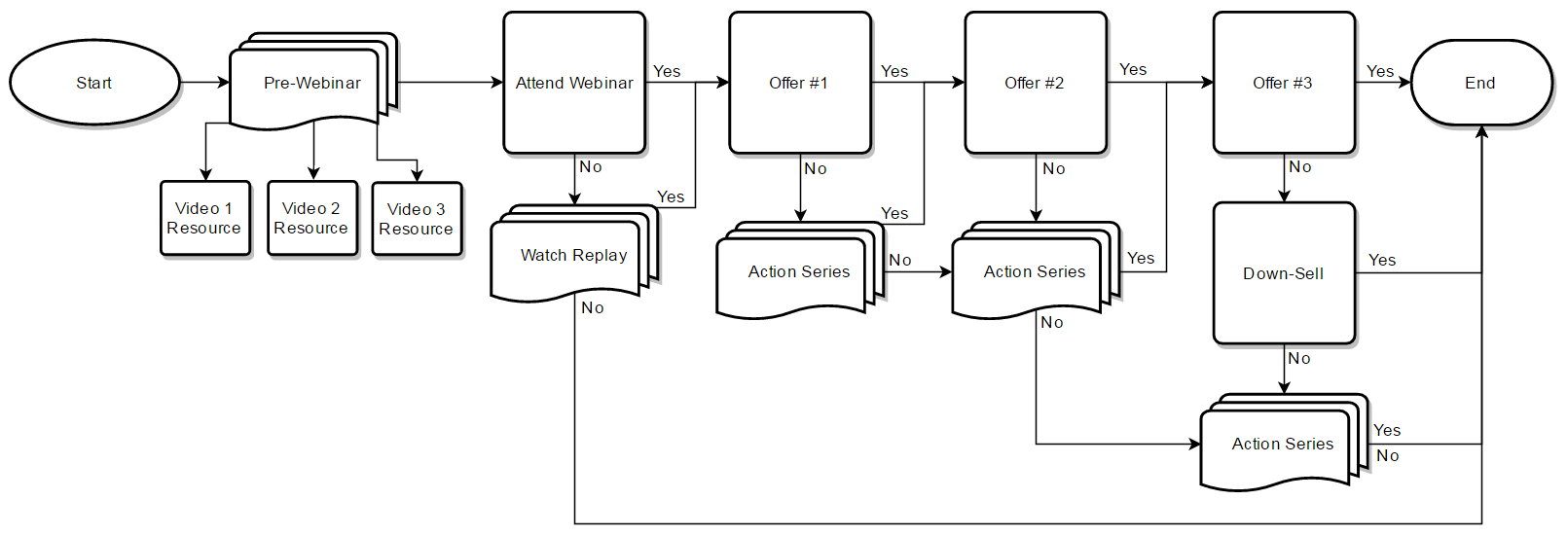
Makes sense, right? You’re already making an offer and if they buy it, you simply offer more.
The “Classic” => Call / Application Funnel

The Call / Application Funnel also fits nicely on the backend of most other funnels, especially when you’re trying to get someone on the phone and/or to qualify themselves for your higher end products and services.
At the end of the day, combine funnels in ways that makes sense for what you offer. Never lose sight of your customer, their needs, and the natural path they should take through your Micro Sales Funnels.
Detailed Micro Sales Funnel Strategies
I have a few complementary articles that go into great detail concerning several Micro Sales Funnel models and I wanted to share them with you here:
- The 2-Step Facebook Lead Gen Funnel
- The Digital Products Sales Funnel
- The Ecommerce / Amazon Sales Funnel
- The “Book” Sales Funnel
Ready For The Next Steps?
That was a lot of great info – wasn't it?!
You'll probably want to read through that section again; however, if you're ready to move on to the next steps…
